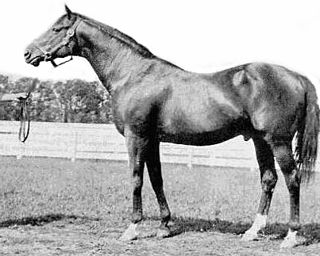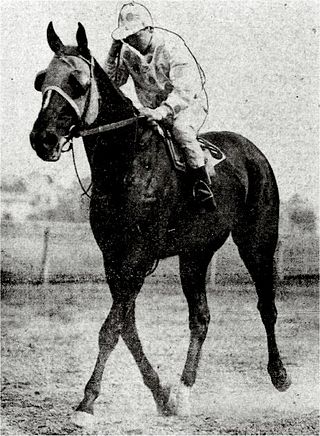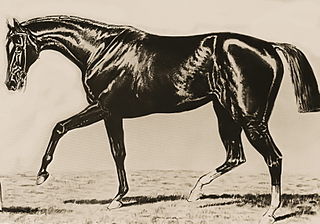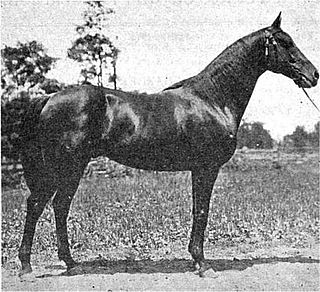
Colin was an undefeated champion American Thoroughbred racehorse who won all his 15 races including the 1908 Belmont Stakes and was the 1907 and 1908 Horse of the Year as well as the 1907 Champion Two-Year-Old Male and 1908 Champion 3-Year-Old Male and was inducted into the National Museum of Racing and Hall of Fame.
The Jockey Club is the breed registry for Thoroughbred horses in the United States and Canada. It is dedicated to the improvement of Thoroughbred breeding and racing and fulfills that mandate by serving many segments of the industry through its subsidiary companies and by supporting numerous industry initiatives.
Castleton Lyons near Lexington, Kentucky, is an American horse-racing stable and breeding business best known by the name Castleton Farm.

Lexington was a United States Thoroughbred race horse who won six of his seven race starts. Perhaps his greatest fame, however, came as the most successful sire of the second half of the nineteenth century; he was the leading sire in North America 16 times, and broodmare sire of many notable racehorses.

Foxhall Parker Keene was an American thoroughbred race horse owner and breeder, a world and Olympic gold medallist in polo and an amateur tennis player. He was rated the best all-around polo player in the United States for eight consecutive years, a golfer who competed in the U.S. Open, and a pioneer racecar driver who vied for the Gordon Bennett Cup. In addition to his substantial involvement in flat racing, he was also a founding member of the National Steeplechase Association.

Kingston (1884–1912) was an American Thoroughbred racehorse. He won 89 races, the most in the history of the sport of thoroughbred racing. Of his 138 starts, he was out of the money only on four occasions. He was later inducted into the United States Racing Hall of Fame.

Commando (1898–1905) was an American Hall of Fame Champion Thoroughbred racehorse.

Maskette (1906–1930) was an American Thoroughbred Hall of Fame racehorse who never lost a race against other fillies.
Edward Riley Bradley was an American steel mill laborer, gold miner, businessman and philanthropist. As well as a race track proprietor, he was the preeminent owner and breeder of Thoroughbred racehorses in the Southern United States during the first three decades of the 20th century. Testifying before a United States Senate committee in April 1934, Bradley identified himself as a "speculator, raiser of race horses and gambler". He appeared on the cover of Time magazine on May 7, 1934. In the year 2000, the Florida Department of State honored him as one of their Great Floridians.

Peter Pan (1904–1933) was an American Thoroughbred racehorse and sire, bred and raced by prominent horseman, James R. Keene. As winner of the Belmont Stakes, the Brooklyn Derby and the Brighton Handicap, he was later inducted into the National Museum of Racing and Hall of Fame. His progeny included many famous American racehorses, including several winners of the Kentucky Derby and the Preakness Stakes.

Spendthrift was a successful American Thoroughbred racehorse and an outstanding sire.
Meddler (1890–1916) was a British Thoroughbred racehorse who was a leading two-year-old in England, when he won all three starts including the Dewhurst Plate. He was then sold to America where he became the leading sire in 1904 and 1906.

Delhi (1901–1925) was an American Thoroughbred racehorse that won the 1904 Belmont Stakes. He was the top money-winner of 1904 and was consequently named the co-historical American Champion Three-Year-Old Male Horse with Ort Wells. The following year, he was also the historical American Champion Older Male Horse, co-champion once again with Ort Wells. While Delhi did have limited success in the stud, he is not considered to be an influential sire.

Foxhall (1879–1904) was an American-bred Thoroughbred racehorse and sire. He was trained in Britain during a racing career that lasted from 1880 until June 1882 during which he ran eleven times and won seven races. As a three-year-old in 1881 he proved himself to be the outstanding colt of the season in Europe, winning the Grand Prix de Paris and becoming the second of only three horses to complete the Autumn Double of the Cesarewitch and the Cambridgeshire.
Old England (1899–1908) was an American Thoroughbred racehorse best known for winning the 1902 Preakness Stakes. Owned and trained by Green B. Morris, he was sired by Goldfinch. Old England was out of the mare Queen Bess, a daughter of Marden.

Cap and Bells was an American-bred Thoroughbred racehorse and broodmare. After showing promising form in the United States as a juvenile in 1900 she was set to race in England. In June 1901 on her British debut she recorded an extraordinary win in the Epsom Oaks, becoming the first American horse to do so. She never recaptured her Epsom form and was retired from racing in 1903. After returning to United States she had some success as a broodmare.
The Keene Memorial Stakes was an American Thoroughbred horse race run for twenty years from 1913 through 1932 at Belmont Park, in Elmont, New York. The race was created to honor James R. Keene who died on January 3, 1913. A Wall Street stockbroker, Keene was a major owner and breeder of Thoroughbred racehorses and would become one of the U.S. Racing Hall of Fame's Pillars of the Turf.
Disguise was an American Thoroughbred racehorse who won the 1900 Jockey Club Stakes in England but is best remembered for his success as a sire.
Authentic is a champion American Thoroughbred racehorse who won the 2020 Kentucky Derby and Breeders' Cup Classic, where he set a new Keeneland track record. He also won the Sham Stakes, San Felipe Stakes, and Haskell Invitational, and was second in the Preakness Stakes and Santa Anita Derby. He was the Horse of the Year and Champion Three-Year-Old Male in 2020 and was the second highest ranked racehorse in the world. He also won the Secretariat Vox Populi Award.
Voter was a Thoroughbred racehorse bred in England that competed in the United States where his racing success led to his selection as the American Champion Older Male Horse of 1899. When his racing career was over, Voter became an influential sire.












